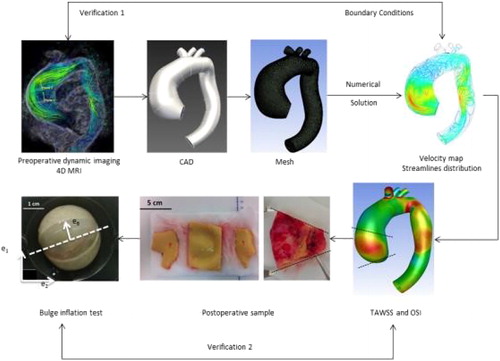1. Introduction
Ascending thoracic aorta aneurysm (ATAA) is the 19th common cause of human deaths. Despite important recent progress to better understand the pathogenesis and the development of the disease, the role played by deranged hemodynamics on the ATAAs risk of rupture is still partially unknown (Cheung et al. Citation2017; Farzaneh et al. Citation2019). The aim of this study is to obtain crucial indications about this role by combining in vivo, in vitro and in silico analyses ().
Figure 1. Workflow overview of the analysis presented in this work. Firstly, the 3D geometry was constructed using patient-specific images; secondly, the CFD model was built and solved using patient-specific boundary conditions from 4D MRI acquisition; thirdly, the CFD model was verified using 4D MRI data. Finally, biomechanics and rupture properties of these samples were assessed.

2. Methods
Computational fluid dynamics analyses were performed on 10 patients using patient-specific geometries and boundary conditions derived from 4D MRI. Blood flow time-averaged wall shear stress (TAWSS), helicity and eccentricity descriptors were assessed (Condemi et al Citation2017). A bulge inflation test was carried out in vitro on the 10 ATAAs after surgical repair (Farzaneh et al. Citation2019). The biomechanics and rupture properties of these samples were derived: burst pressure, physiological tangent modulus (Ephysio), Cauchy stress at the rupture stage (σrup), rupture stretch (λrup) and rupture stretch criteria (γstretch). Spearman's rank-order correlation was performed to determine association between all variables.
3. Results and discussion
The results showed a statistically significant (p < 0.01) negative correlation between Ephysio and the TAWSS (r = −0.77 and p = 0.009). A statistically significant positive correlation was found between σrup and the TAWSS (r = 0.879 and p = 0.001) and between λrup and the TAWSS (r = 0.867 and p = 0.001).
Understanding the relationship between hemodynamics descriptors and rupture risk is not a trivial issue and there is still a pressing need to conduct research on their possible correlation for potential application in clinical prognosis. Chooi et al. (Citation2016) showed that low residence time reduces the water flux and the advection of macromolecules into and across the arterial wall. Moreover, low oscillatory WSS has been shown to disturb endothelial cells in a number of locations of the arterial tree (cerebral aneurysms, coronaries) which may induce a larger permeability of the wall. It is well known that larger TAWSS is often associated with lower oscillatory WSS and lower residence time of particles. Therefore, our findings lead to the hypothesis that relatively higher TAWSS may induce a ‘washing effect’, limiting this advection of macromolecules. The phenomenon of ‘outward convection’ was recently defined by (Michel et al. Citation2018). They showed that it is dependent on hemodynamic factors, such as pressure and wall shear stress, and on the aortic properties, such as permeability. More specifically, this biomechanical phenomenon results into blood-borne plasminogen infiltrating in the arterial wall. This may induce a proteolytic injury and cause damage of the extracellular matrix, in particular elastin. This would explain why the higher ultimate stress were found for aTAA exposed to higher WSS and weaker properties (lower rupture stretch) were obtained for aTAA having smaller values of TAWSS. According with these trends, the WSSmax and the TAWSSmax negatively correlate with γstretch and Ephysio. This stretch criteria ranges between 0 and 1. The closer it is to 1, the larger is the risk of rupture. From our results, high value of γstretch are associated to lower WSSmax and TAWSSmax. However, these results still need to be confirmed on a larger cohort and also to be reconciled with the results of (Guzzardi et al. Citation2015) who showed more elastin damage in the ascending aorta of BAV patients in the regions exposed to larger WSS. However, these studies cannot be directly compared considering that (Guzzardi et al. Citation2015) looked at regional correlations between WSS and elastin proteolysis whereas our study found inter-individual correlations between WSS and rupture properties.
4. Conclusion
In conclusion, this study demonstrates that large TAWSS have a protective effect in ATAA as they are related to larger rupture properties and smaller stiffness. Further investigations will be extended to a bigger cohort of patients.
Acknowledgements
We are grateful to Ansys, Inc. for providing AnsysFluent (ANSYS® Academic Research, Release 17.2).
Additional information
Funding
References
- Cheung K, Boodhwani M, Chan KL, Beauchesne L, Dick A, Coutinho T. 2017. Thoracic aortic aneurysm growth: role of sex and aneurysm etiology. JAHA. 6(2):003792.
- Chooi KY, Comerford A, Sherwin SJ, Weinberg PD. 2016. Intimal and medial contributions to the hydraulic resistance of the arterial wall at different pressures: a combined computational and experimental study. J R Soc Interface. 13(119):20160234.
- Condemi F, Campisi S, Viallon M, Troalen T, Xuexin G, Barker AJ, Markl M, Croisille P, Trabelsi O, Cavinato C, et al. 2017. Fluid- and biomechanical analysis of ascending thoracic aorta aneurysm with concomitant aortic insufficiency. Ann Biomed Eng. 45(12):2921–2932.
- Farzaneh S, Trabelsi O, Avril S. 2019. Inverse identification of local stiffness across ascending thoracic aortic aneurysms. Biomech Model Mechanobiol. 18(1):137–153.
- Guzzardi D G, Barker A J, van Ooij P, Malaisrie S. C, Puthumana J J, Belke D D, Mewhort H E.M, Svystonyuk D A, Kang S, Verma S, et al. 2015. Valve-related hemodynamics mediate human bicuspid aortopathy: insights from wall shear stress mapping. J Am College Cardiol. 66(8):892–900.
- Michel JB, Jondeau G, Milewicz DM. 2018. From genetics to response to injury: vascular smooth muscle cells in aneurysms and dissections of the ascending aorta. Cardiovasc Res. 114(4):578–589.
